Houston artist Paul Horn began making art when he was twelve years old under the nom de plume The Orange Gringos (a name the artist points out has now been ruined by Donald Trump). Back then (and still today), he would make mixtapes of prank calls played on unsuspecting strangers. This was 1988, two years before Bart Simpson unleashed his “I. P. Freely” gag, and eight years before “Weird Al” Yankovic released Phony Calls, a parody song warning of the dangers of fooling strangers.
Horn, like many of us, played with the standby toys of his day and was indoctrinated into Star Wars and The Force early on. He collected the franchise’s action figures, using them to set up fictional scenes that created crossover fantasy worlds. Horn’s home life had an additional layer of forced pop-culture exposure: his father worked for the grocery chain Randalls and would bring home props from product-placement store displays, meaning that from the beginning, advertising was front and center in the artist’s life.
As Horn grew older, in the pre-internet era, he developed a punk approach to making and distributing art. Horn would donate his prank call mixtape CDs to Goodwill, using the institution’s built-in models of distribution in place of a record label. He would do this with his art too, hoping that some unsuspecting shopper might take pleasure in a slightly altered object that was, in fact, a Paul Horn original. If you know Horn’s way of creating, this type of distribution makes sense, because he uses objects that you would find in a Goodwill anyway: Spongebob sheets, Happy Meal toys, monster masks, faux flowers, Christmas ornaments, and used crutches have all played central roles in Horn’s assemblages.
Horn broke into the Houston art scene in a nontraditional way: with a garage sale. In 2000, he set up Garage Sale Once Removed on Colquitt Street in the middle of Houston’s (then-) gallery row. From there, he organized an exhibition in a Quick Mart convenience store, and perhaps most infamously in 2002, put together Million Dollar Hotel, a knock-down-drag-out art show/party held on the entire rented top floor of a Holiday Inn. The opening featured clowns (courtesy Dolan Smith’s simultaneous show Clown Town), a gaggle of Santa Claus impersonators, and more local art legends (showing art and wandering around) than you could count. It was a roaring success.
Later that year, Horn opened Death Metal 2000: Prehistoria at Texas Gallery in Houston. The show received write-ups in Glasstire (by Mark Flood), the Houston Press (by Kelly Klaasmeyer), Artlies (by Catherine Anspon), Art Forum (by Susie Kalil), and Art in America (by Frances Colpitt). The critics were cautiously optimistic about Horn and the show, sprinkling their assessments with veiled (but true) praise-cum-insults like: “DEATH METAL 2000: Prehistoria is full of crap. If plastic hadn’t been invented, this show wouldn’t exist,” and, “DEATH METAL 2000: Prehistoria included 17 assemblages and two or three questionable tableaux that may or may not have been works of art.”
Horn had another solo show at Texas Gallery in 2005 and participated in group shows in the city and beyond before hitching himself to Houston’s Deborah Colton Gallery (where he’s represented today). Horn’s next self-organized extravaganza was Yard Sale Time Machine in 2010. Featuring googly eye objects by The Art Guys and a pseudo set-up of Bill’s Junk (the artist Bill Davenport’s permanent art-thrift store), the show was a disorganized, art-inspired “yard sale” in every sense of the word. Horn’s most recent event series, Cheeseburger Cheeseburger Part I (2011) and II (2013), was hosted in a rented McDonald’s birthday party room. Featuring free Happy Meals and a sheet cake (they came with the rental), the ad-hoc events included baroque costumes donned by host and guests, gift-wrapped sculptures, body painting, and some live piano.
There’s a Surrealist impulse that Horn brings to all of his ideas — a sort of organized chaos in which every component of his project has its unlikely place. His events recall 1960s happenings merged with Cabaret Voltaire; a seemingly normal situation goes slightly awry, taking a marginally different path than it should follow, before dissenting into near madness. But it all seems intentional. When I asked Horn what his favorite thing to create is, he said: “Event planning.”
When talking about these performative ventures, he uses language similar to that of installation and land artists: the buildings and environments he creates become the art. They’re a sort of social sculpture — a temporary fantasy world sprung from the artist’s head that you, as a visitor and participant, inhabit. You’ve left Planet Earth behind and stumbled into Horn’s own strange world.
Horn’s aesthetic is that of overabundant kitsch. His discrete artworks employ mass-produced, low-brow, throwaway objects in one of the most overblown assemblage styles I’ve ever seen. Horn is a graduate of the Columbus College of Art and Design, and was an MFA candidate at the University of Houston before getting kicked out; the creation of his pieces is informed by color theory and how the objects that go into his work physically come together to create a tableau. His decisions are almost never random, even if they appear off-the-cuff.
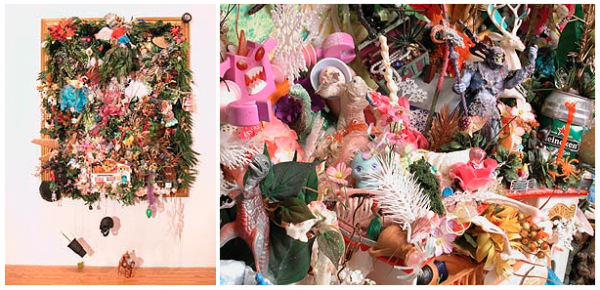
Paul Horn, Buried Animals are Calling Your Name, 2002, from Death Metal 2000: (Prehistoria) at Texas Gallery
The camp, scattered quality of Horn’s work is inherent to how he lives his everyday life. A lover of bad movies, especially “shitty sequels,” (Indiana Jones and the Temple of Doom is his favorite movie of all time), a collector of National Enquirers, and an avid fan of The Mandela Effect, conspiracies and alternative realities, it often feels like Horn has never quite grown up. His work has progressed in notable ways (he has a self-deprecating series called Crappy Versions of My Old Art), but Horn radiates a child-like wonder that has him facing each passing day as a totally new and blank canvas. His lack of inhibition, especially in this era, is impressive. Horn does what he wants to do, no matter how wrong or controversial it is. And because he’s so unabashedly open and adventurous, sometimes he gets it right, and sometimes he gets it wrong.
Because Horn wants to suck you into his own world, his tendency toward all-overness and his lack of editing can, even by art-world standards, feel out of hand. Even in his unique and domestically sized assemblages, there’s a profusion of detail that’s easy to get lost in, but if you dedicate time to the work, you’ll find subtle, poetic moments where breathtaking art takes place. Embedded in the glitter-covered Barbie heads and fake dog poop are profound critiques of power structures, complacency, the history of art, and high and low culture. Horn’s work — both the gonzo events and single works— comment on consumerist culture and how we surround ourselves with objects onto which we project false value.
If you’ve been lurking around the Houston art scene only for the last few years, it’s likely that you’ve never met Paul Horn. Save for his inclusion in the occasional group show at Deborah Colton Gallery, he’s been strangely silent — no booze-fueled romps, no outrageous parties. After a year and a half of trying to get in touch with Horn, I finally visited him about a month ago. In true Paul Horn fashion, instead of a studio visit, he offered me my own private art show — an exhibition created specifically for the eyes of Brandon Zech. I drove up to the Woodlands, 50 minutes north of Houston, to Horn’s suburban house to see his (my) Garage Sale of Doom.
Having my own private art show felt gluttonous — the exhibition took the concept of a studio visit to another level. In the 24 hours since he decided to make the personalized show, Horn had painted cardboard boxes white to stand in for gallery pedestals, dug out an assortment of older works, and created all new assemblage-y situations on his front lawn. Complete with an inflatable Santa-hatted Minion, the show had a lot going on: globs of paint still wet to the touch, zombie-like gnomes emerging from the artist’s woodchip-covered garden, fake plants stuck in the middle of the yard, iced box wine (Horn claimed that it’s much better than that stuff galleries serve at their openings), art made with his son’s toys, and a panting by Solomon Kane that was technically part of the exhibition but had been frisbeed onto the roof, making it impossible to view.
While taking in this barrage of contorted and abused pop culture, I understood that the key to Horn’s whole way of working is that he capitalizes on objects that are already so good they may as well be art themselves. In the spirit of the readymade, these are all objects that can save him a step in the whole art-making process. Horn’s light manipulations of these aestheticized, market-tested items is his art’s bread and butter, but it’s also a delicate balance to land: come on too strong and destroy the inherent amazingness of the object itself, or do too little and have the joke/critique be consumed by the object.
One assemblage in the lawn show that exemplified this idea was Awkward Silence from Being Hangry, a piece sitting in the garden comprised of a small, roaring yard-art lion, which Horn surrounded with store-bought bloodied bones, antlers, and detached limbs designed originally as Halloween decorations. The lion, as a starting point, references MGM, or the fate of an unlucky safari goer, or the logical outcome of the biblical story of Daniel, and Horn takes the piece to its gruesome, yet strangely rational conclusion: it’s a dog-sized, murderous monster. Do the dripping, severed limbs belong to one unlucky individual (a proxy for me, the viewer), or did the beast somehow manage to take down multiple victims at once? When talking about his work, Horn offhandedly said a phrase that may as well be his artist statement: “Laziness breeds invention.”
The theme I found in Awkward Silence from Being Hangry wasn’t a unique occurrence in the garage sale show. When seen in person, Horn’s works have a sinister undertone, a macabre through-line of doom and gloom that undercuts the happiness we normally associate with his materials. Monster masks are turned even more sinister when they’re dismembered and rearranged; porcelain figurines of unicorns — the idealized animal of tween fantasy and Millennial pseudo-irony — sit adjacent to set of bloodied, spring-loaded teeth; a zombified Superman, with his jet-black hair and a glitter encrusted “S,” sits in a plastic box, incapacitated by a black ring that has been hooked around his arm and a pile of fluffy objects across his lap.
Other pieces in Garage Sale of Doom were subtler and took more time to digest. There was a large glass bottle clad in a customized tiny toddler shirt on which the text “I HAVE THE BEST MOM & DAD” was overlaid atop a photograph of a sunglass-wearing couple. Inside the bottle, a plastic, anatomically correct heart — too large to fit through the container’s opening — leaned abjectly to the side as if about to topple. Horn says he found the shirt in a thrift store, and it makes one wonder why it was given away in the first place; why would an object made specifically and lovingly for a small child not be kept by the parents as a memento? Did something horrible happen to the child? With Horn’s contextualization, these are the kind of questions that float up — a tender object is made viscerally unsettling by the addition of a full-grown heart that never was.
Some of the things in the exhibition that weren’t “quite right” were found objects Horn has collected over the years. He loves going to Mexico, and brings back knock-off statues of pop-culture icons that look similar enough to their inspiration to pass, but just wrong enough to be off-putting. The most striking of these was a weathered, smirking, stone Spongebob whose face didn’t quite line up with its body. Other finds included a blocky version of Mater from Disney-Pixar’s Cars, and a maniacally smiling Shrek. Their unintentional wrongness made them readymade Paul Horn sculptures.
Permeating throughout the doomsday cloud created by this array was a fake air of happiness in the form of glitter. Coating nearly half the pieces in the show (some on accident — after all, glitter is the herpes of craft supplies), the glistening granules strained to bring Horn’s objects back from death’s door. Horn’s appreciation of glitter comes from his understanding of it in terms of human survival; he believes that when cavemen saw water, they were attracted to the sheen of its surface and kept looking for it — an evolutionary trick. He believes we have a basic human attraction to shiny, ostentatious objects, and he likes to capitalize on that. Sometimes Horn uses glitter as a stand-in for snow; in other instances, he revitalizes objects like animated mantelpiece figurines otherwise trapped in the 1970s. It even serves as a surrogate for cocaine, cut into lines on a mirror.
Above all, Horn is a collector, and the best-case scenario is when he transforms his stuff into pointedly critical compositions. The objects he gathers together create new meaning — there’s intentionality behind his clutter. I agree with what Mark Flood wrote in his review of Horn’s Death Metal 2000: Prehistoria exhibition back in 2002:
Horn isn’t a garbage artist. He doesn’t process every material thing that crosses his path. This show confirmed for me how very specific his choices are. The same things are used over and over, which proves he’s not finding, he’s seeking.
Horn can be a victim of the very trap he’s critiquing, with the pop-culture reference overload creating a vicious self-cannibalizing cycle. The irony of Horn’s work is that while its suburban detritus should make it easy to access, conceptually, its grounding in the cheap and throwaway materials makes it sometimes feel less-than. Art institutions don’t contextualize his work very easily, so Horn responds by creating his own worlds where you don’t expect to encounter “fine art” at all: hotel rooms, convenience stores, McDonald’s party rooms, and suburban lawns. By bringing you to such unlikely places and putting a drink in your hand, Horn hopes you’ll shed your assumptions and received notions of art and finally look at what’s in front of you.
For Garage Sale of Doom, the act of traveling 50 minutes outside of the city in order to see an art show that looked like a suburban house had vomited its contents onto its front yard was a surreal experience — one that I imagine was simpatico with other Paul Horn productions. In talking to the artist over the past several weeks, it feels like Horn is ready to come back from his fallow period. He’s currently working on, in collaboration with roving artist Jeff Wheeler, a prom-themed exhibition and party to be hosted in a functional basketball gymnasium and locker rooms. Whether it’s fully planned-out or ill-advised, I’m sure it’ll be a spectacle, if nothing else.
This article was made possible through the support of the Mid-America Arts Alliance, the National Endowment for the Arts, and the state arts agencies of Arkansas, Kansas, MIssouri, Nebraska, Oklahoma, and Texas.



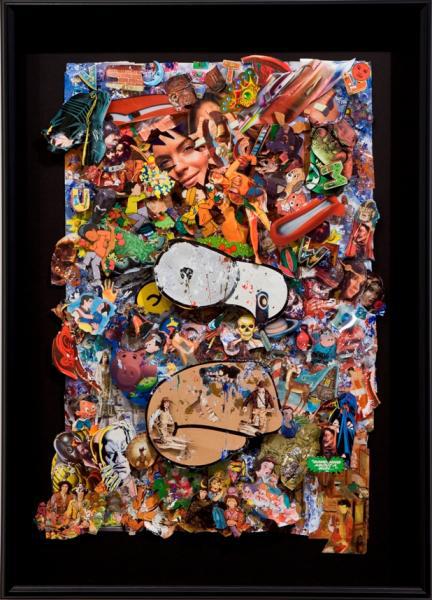
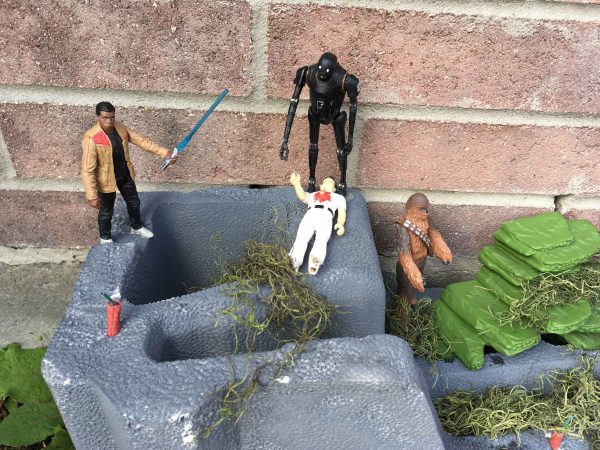

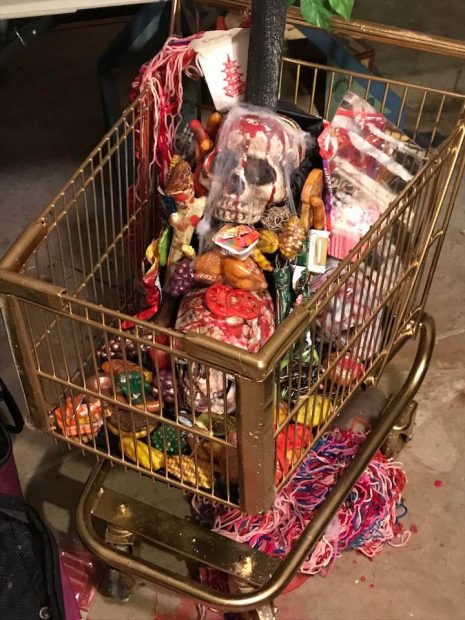
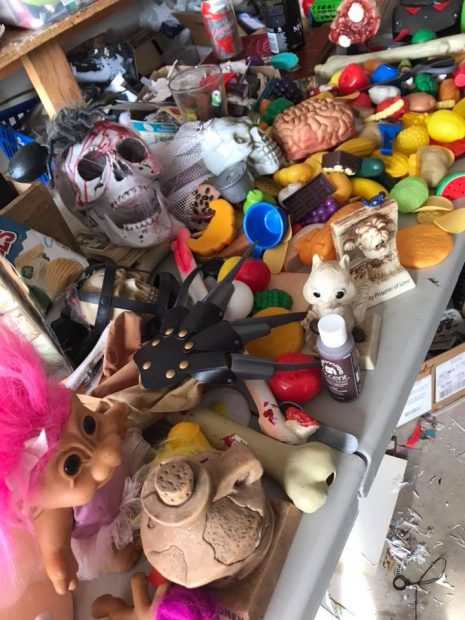
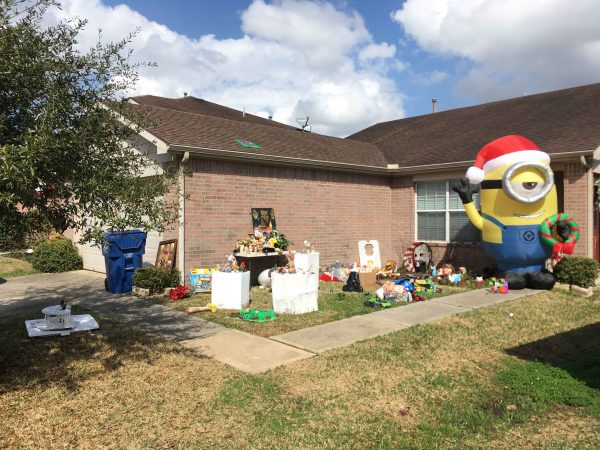


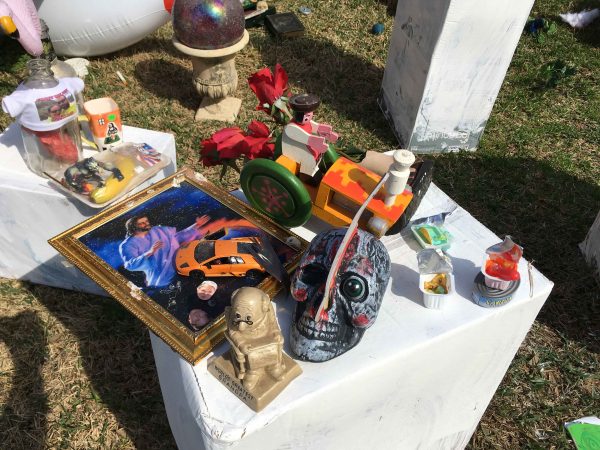

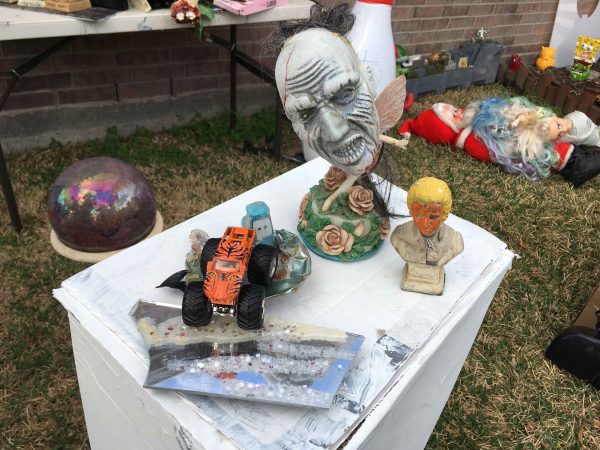
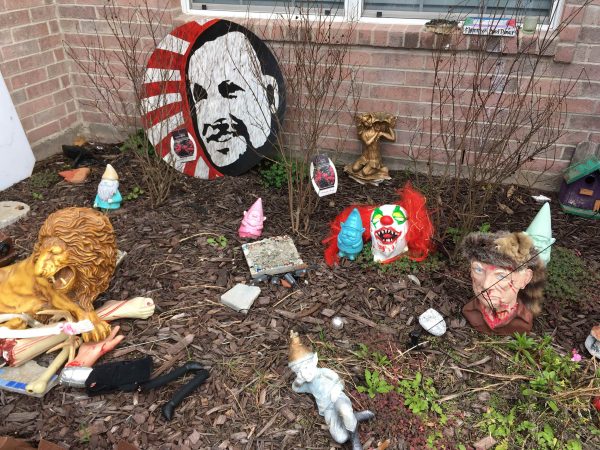
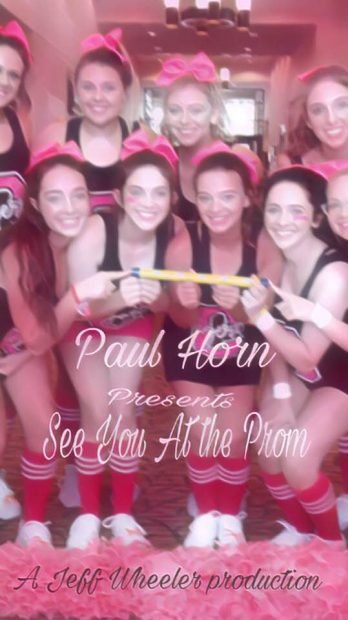

2 comments
Paul Horn lives! This is GT highlight for me. Thanks for the thorough essay, Brandon. If only more artists operated with unbridled energy and intuition.
“Horn isn’t a garbage artist. He doesn’t process every material thing that crosses his path. This show confirmed for me how very specific his choices are. The same things are used over and over, which proves he’s not finding, he’s seeking.” I think a nice added layer to this Flood review is that it was personal for Mark. He built a relationship with Jack Pierson by traveling around TX, seeking letters for Pierson’s word sculptures.
A thorough, enjoyable and enlightening essay about an artist I might not otherwise have heard about. Well done.